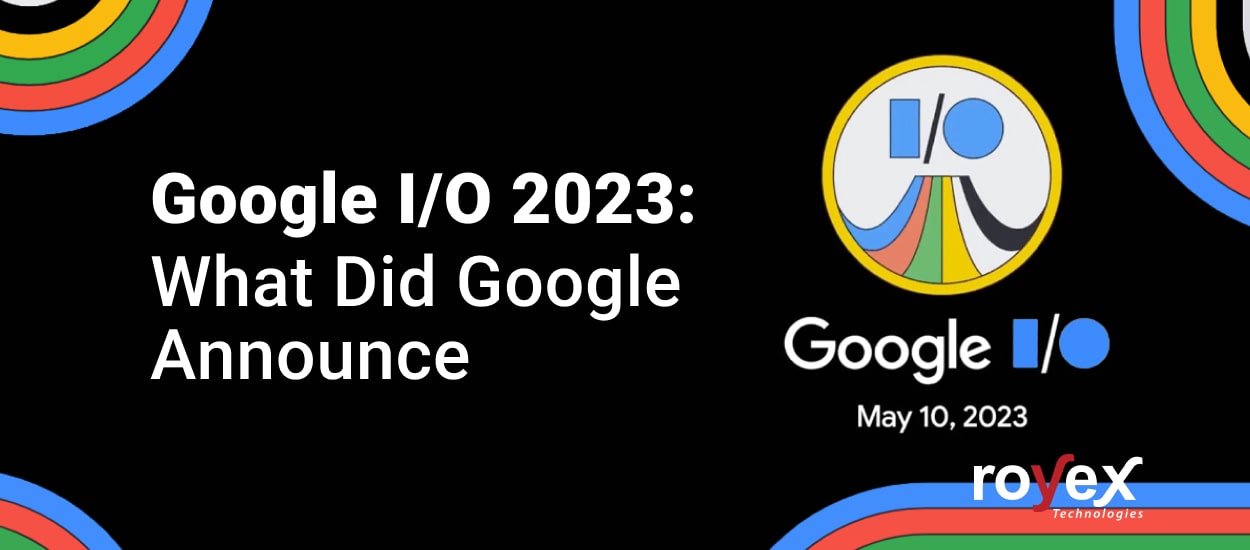
Google IO, Android Studio Bot, Mobile App Development
The largest event of the year for Google took place at the annual Google I/O 2023 developer conference, where the tech behemoth offered a sneak peek of Android 14, as well as anticipated releases of its inaugural foldable phone - Pixel Fold, Pixel 7a, and Pixel Tablet.
Other announcements included unveiling features such as Find My Device, WearOS for WhatsApp, an Unwanted Tracker Alert, and others. Additionally, Google demonstrated how generative AI is transforming the landscape of its services and influencing the future.
Find out all the major announcements at the Google I/O 2023 in this article.
Three new additions to the Pixel lineup
During the keynote presentation, Google unveiled three new products that placed their Pixel hardware in the spotlight: the Pixel Fold, the Pixel Tablet, and the affordable Pixel 7A.
Priced at $1,799, the Pixel Fold represents Google's first venture into the foldable device market. The phone boasts a 5.8-inch OLED external screen that unfolds to reveal a larger 7.6-inch OLED panel with a 120Hz refresh rate. Additionally, the $499 11-inch Pixel Tablet functions as both a conventional tablet and a smart display, thanks to the included magnetic charging dock that also doubles as a speaker.
Finally, the Pixel 7A has been added to Google's mid-range A-series lineup. Like the Pixel Fold and Pixel Tablet, the phone features Google's Tensor G2 chip, as well as a 6.1-inch 1080p display with a maximum refresh rate of 90Hz. The phone's base version retails for $499, but some carriers will offer a more expensive $549 option that supports millimeter wave (mmWave).
Pixel Fold - Google’s First Foldable Smartphone
The Pixel Fold boasts a sleek design that measures 139.7 x 79.5 x 12.1 mm when folded and 139.7 x 158.7 x 5.8 mm when unfolded, with a weight of 283g. The phone has an IPX8 water resistance rating (but not dust resistance). The external screen is a 5.8-inch 1080x2092 17.4:9 120Hz OLED display with Gorilla Glass Victus, and up to 1,200 nits HDR brightness and 1,550 nits peak brightness.
The inner screen is even more impressive, featuring a 7.6-inch OLED display with a 6:5 aspect ratio, 2208x1840 resolution, 120Hz refresh rate, and Ultra Thin Glass with a protective plastic layer on top. It has up to 1,000 nits HDR brightness and 1,450 nits peak brightness.
The hinge is designed to provide "fluid friction across the full 180-degree range of motion to securely support different postures." The phone is powered by Google's Tensor G2 SoC, which includes the Titan M2 security coprocessor. The device has 12GB of LPDDR5 RAM and 256 or 512GB of UFS 3.1 storage.
The rear of the phone boasts three cameras: a 48 MP main camera with 1/2" sensor size, 0.8 μm pixel width, f/1.7 aperture, and OIS, a 10.8 MP ultrawide camera with 1/3" sensor size, 1.25 μm pixel width, and f/2.2 aperture, and a 10.8 MP 5x optical zoom telephoto camera with 1/3.1" sensor size, 1.22 μm pixel width, f/3.05 aperture, and support for Super Res Zoom up to 20x.
The external screen features a 9.5 MP fixed focus camera with 1.22 μm pixel width and f/2.2 aperture, while the internal screen has an 8 MP snapper with fixed focus, 1.12 μm pixel width, and f/2.0 aperture.
Other notable features include a fingerprint sensor embedded in the power button, dual SIM support (one physical slot, one eSIM), stereo speakers, and a 4,821 mAh battery that supports Google's 30W USB-C charger with USB-PD 3.0 (charger sold separately). The phone runs on Android 13.
Google’s New Pixel Tablet
Google has announced the Pixel Tablet, which is now available for pre-order and will begin shipping on June 20th for $499. The tablet is designed to excel in activities like video watching and gaming, but it doesn't make any bold statements about the future of computing.
The Pixel Tablet has a rather ordinary appearance, with an 11-inch 2560 x 1600 pixel LCD display with even bezels and a matte back. It comes in three colors: white, dark green, and light pink, with the dark green model featuring a black bezel.
Despite its plastic-like appearance, the Pixel Tablet has an aluminum frame with a nanotexture coating, much like the Pixel 5 smartphone. The Pixel Tablet comes with a magnetic speaker dock that serves as a charging station and a storage solution, preventing the "dead tablet in a drawer" syndrome.
The dock also features a louder and fuller speaker for communal listening, seamlessly switching audio output from the tablet's speakers to the dock's speakers when docked, and vice versa when removed.
Pixel 7A
Google's new Pixel 7a smartphone brings several notable upgrades to the Pixel series. One of its standout features is the 6.1-inch OLED display, which now has a 90Hz refresh rate, the same as the Pixel 7 (which has a slightly larger 6.3-inch display). The resolution is FHD+ and the screen is protected by Gorilla Glass 3.
The phone is also IP67-rated for dust and water resistance, with a metal frame and a plastic back made from recycled materials such as aluminum, glass, and plastic. The device comes in three colors: Charcoal, Sea, and Snow.
Under the hood, the Pixel 7a is powered by the Tensor G2 chipset, paired with 8GB of LPDDR RAM and 128GB UFS 3.1 storage, a configuration that matches the Pixel 7. The phone also boasts a 64MP camera sensor that supports Super Res Zoom up to 8x, an upgrade from the 12MP camera on the Pixel 6a. The rear camera has a 13MP ultra-wide sensor and the front-facing camera has been bumped up to 13MP as well.
The Pixel 7a supports sub-6GHz and mmWave flavors of 5G, though mmWave will only be available in select regions. It is also a dual-SIM device, with one physical nano-SIM and one eSIM. Google promises 5 years of security updates for the phone.
AI-powered “snapshots” in Google Search
Google has announced a major update to its search engine with a new feature called AI snapshots. This feature is part of the Search Generative Experience (SGE) and will provide AI-powered answers at the top of search results for certain queries.
The answers will provide more context to the search and can be further narrowed down with follow-up questions. The AI snapshots are powered by an updated version of Google's large language model (LLM) called PaLM 2, which has already been integrated into 25 of Google's services, including the Bard chatbot. The new model includes improvements in reasoning, coding, and translation.
Bard is now open to all
Google has made its AI-powered chatbot, Bard, available to all users, without requiring them to be on the waitlist. The company has also introduced several new features to the chatbot, including support for Japanese and Korean languages, an easier way to export generated text to Google Docs and Gmail, and new dark mode and visual search features.
Google intends to expand the chatbot's functionality even further in the future, with plans for AI image generation using Adobe's Firefly, and integration with third-party services like OpenTable and Instacart.
AI-powered customizations are now available on Android
Google has announced that new AI-powered features are coming to Android. One of these features, called Magic Compose, will be available in the Android Messages app, allowing users to reply to messages using AI-generated responses.
Another feature will allow users to create their own wallpaper by describing an image, which will be generated using Google’s text-to-image diffusion model. Furthermore, next month, a Pixel-exclusive feature will be launched, allowing users to add depth to their photos by using a new "cinematic wallpaper."
Wear OS 4 launching later this year
Google has already begun work on Wear OS 4, despite the fact that Wear OS 3 has not yet been fully launched. The company revealed that the updated operating system will have enhanced battery life, the ability for users to back up and restore their watches, and new accessibility features.
In addition, Wear OS 4 will offer improved smart home integrations, enabling users to adjust lighting, control media, and view animated camera notifications directly from their watches. Currently, Wear OS 4 is only accessible in a developer preview and emulator, with a full release expected later this year.
Google Home app gets a revamp
Starting Thursday, May 11th, the redesigned Google Home app will be available to everyone, as it is no longer in an invite-only public preview. The updated app includes several significant enhancements, such as an improved camera interface, a new Favorites tab, and support for a wide range of new device types.
Google Search’s new Perspectives feature
Google recently introduced a new Perspectives filter that enables searchers to filter their search results to show outcomes from forums, blogs, and videos. Liz Reid, VP of Search at Google, said that these results aim to offer searchers a more genuine and lived-in experience to their search queries.
The younger demographic is more likely to engage with user-generated content that provides answers from people who are sharing their personal viewpoints. When the perspectives filter is clicked, searchers will see more long and short-form videos, images, and writing posts that have been shared on discussion boards, Q&A sites, and social media platforms.
Additionally, Google will display more information about the content creators, such as their names, profile photos, and the popularity of their content.
Google Photos gets an AI-powered Magic Editor
A new AI-powered editing feature is coming to Google Photos that allows users to make significant changes to their photos, including enhancing the sky, moving objects, and removing people from the background. This feature will be available in early access to some Pixel users later this year.
Google Photos' Magic Editor feature allows users to easily enhance their photos without needing advanced editing skills like those required for Photoshop. With Magic Editor, users can reposition the subject of their shot for the best composition, adjust specific elements like the background and sky, and improve overall lighting. This feature will be available in early access to select Pixel users later this year.
Google introduces Duet AI for Workspace
At the I/O keynote, Google revealed that it is renaming its suite of AI tools for Docs, Sheets, Slides, Meet, and Gmail to Duet AI. This Workspace features offer capabilities such as email composition and image generation from text in Slides, but they are currently limited to those on the waitlist.
Royex Technologies is a Mobile app, E-commerce, Metaverse, AI, and Game Development Company in Dubai that provides services for Government, Enterprise, and SME organizations. We have developed and successfully delivered over several hundred projects for our clients in UAE, Qatar, and other Middle Eastern Countries.





